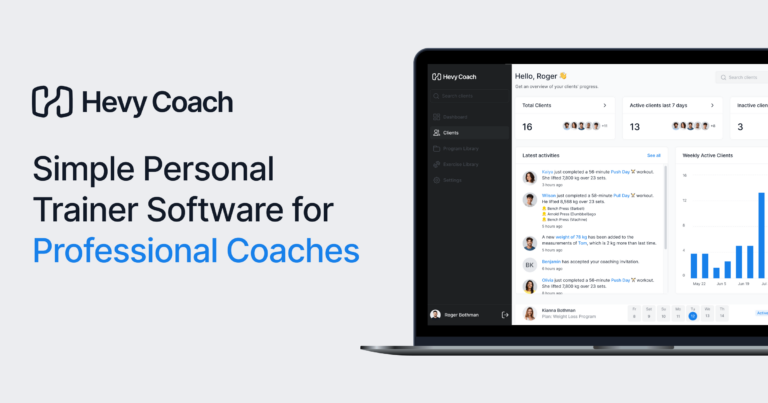The fitness industry is saturated and incredibly competitive, with trends indicating even more growth for at least five more years. While growth is exciting and means there is demand, it also reveals a scary truth:
Putting your name out there and making money becomes increasingly challenging.
One effective way to set yourself apart from a significant percentage of your competition, build a following online, and land clients is to produce helpful content.
But what content should you create, what format works well, and how do you decide what topics to cover?
Read on because we are answering these and other questions below. We’ll also share 16 fitness content ideas to expand your reach, develop your reputation, and firmly establish yourself as a fitness expert.
What are Good Fitness Content Ideas?
Some of the best fitness content ideas include weight loss tips, observations (as a coach), fitness gear, apps, and software reviews, fitness challenges, current trends and affairs, Q&A segments, and research breakdowns. Good content formats include blog posts, email newsletters, long and short videos, and social media posts.
16 Fitness Content Ideas to Expand Your Reach and Help People
1. Weight Loss Tips and Guides
Weight loss has always been and will continue to be a topic of interest. According to some sources, the market size of the weight loss industry was a staggering $224.27 billion in 2021 and is projected to almost double in size by 2030––to $405.4 billion.
Plus, with the ever-increasing obesity rates, many people will need guidance to shed weight and improve their health. So, why not provide that yourself?
While there is a lot of weight loss information, sharing your unique take in the form of actionable tips, an overview of common mistakes, and step-by-step guides can help you build your audience.
2. Anecdotes and Practical Takeaways
Are you an experienced trainer or coach who’s worked with hundreds, if not thousands, of people over the years? Why not share your experience with a larger audience and sprinkle each story or anecdote with a practical takeaway or actionable tip?
For example, let’s say that, despite how hard you tried, you couldn’t get one of your clients to perform the conventional deadlift with proper form. Maybe you tried mobility and warm-up routines to help them loosen up and get into the correct starting position.
But then, you switched to the sumo stance, and it all clicked for them. Their starting position was almost ideal from the start, the movement pattern looked far cleaner, and they were more comfortable with that variation.
Share your story with people and open a discussion on sumo and conventional deadlifts. That simple anecdote could be the foundation of a helpful blog post.

Try Hevy Coach
Intuitive personal trainer software, with a world class experience for your clients.
30 day free trial, no credit card required
3. Client Spotlight
As an extension of the previous point, you can also produce content that largely focuses on clients’ stories, struggles, and transformations. Explain how you’ve helped them reach their goals and ask them to write a few words or record short videos about their experience working with you.
The advantage of creating such case studies is that prospective clients get a better idea of how you can help and what the coaching process might look like. Plus, you would regularly display social proof, making people more interested in hiring you.
You can also use parts of these case studies as opportunities to create helpful content on various topics. For example:
- “How John overcame his binge eating tendencies (and what strategies helped)”
- “How Abby added 50 lbs to her back squat (copy her training split)”
- “An in-depth look into Matthew’s 100-lb weight loss transformation (and what both of us learned)”
4. Workouts for Different Goals
While cookie-cutter workout solutions rarely work well for the average person, they still offer value. For example, even if someone doesn’t use a specific workout, they can take it as inspiration and create something for themselves.
Alternatively, people can modify a specific workout to fit their needs. The recommended volume may be too much or too little for them. Or perhaps they dislike a particular exercise you recommend.
Either way, they can take the routine and make it their own by modifying specific variables. You could generate hundreds of fitness blog post ideas in that area.
5. Healthy Recipes (with Nutritional Information)
Are you interested in running a wellness blog, social media account, or Youtube channel? If so, sharing healthy recipes could be the perfect option for you.

Of course, this works best for people who enjoy cooking because you should prepare the recipes yourself. That way, you can better understand each recipe, take photos or videos of the individual steps, and make modifications.
Include all the relevant information:
- The ingredient list
- What items should people have for each recipe
- How long it takes to prepare
- What the nutritional information is (calories, protein, carbs, and fats)
6. Share Your Story, Past Failures, and Successes
Sharing your story is more of a one-off thing you can and should do. The amount of helpful information and practical takeaways you can extract from your story is limited, and people would grow tired of hearing the same thing multiple times.
That said, talking about your fitness journey, the roadblocks you’ve had to overcome, and your successes can be a great way to appear more human and engage with people in a similar situation.
7. Review Fitness Gear
Some brands are almost exclusively built on product reviews. The approach works because:
a. There are countless products in hundreds of categories you can review
b. New products come out all the time
Take GarageGymReviews as an example––the website and Youtube channel review all sorts of products that help people make more informed purchasing decisions and build great home gyms.
One advantage of this approach is that there is affiliate marketing income potential. For example, you can include affiliate links if you review a product. People interested can purchase through your link, and you would earn a commission at no extra cost to the buyer.
8. Write About Software and Apps
Like fitness gear, you could write or make videos about software and apps. New software comes out all the time, and there are hundreds of fitness apps to talk about.
The advantage of writing about software and apps is that gaining access and testing things for yourself is easier. Even paid apps and software come with free trials. In contrast, reviewing squat racks, barbells, weight plates, adjustable dumbbells, and other equipment can be trickier because it’s harder to access.
Speaking of software, check out Hevy Coach if you want an all-in-one platform to train your clients. The platform makes it easy to write and deliver workout routines to clients, track their progress, make adjustments when necessary, and more, all from a single dashboard.
9. Break Down Research
Like software, apps, and fitness gear, new research comes out all the time, and there are countless studies dating back decades, which means you will always have fitness blog ideas.
There are a few drawbacks, though:
- Most journals require a subscription to access, which means you must pay to gain full access to the latest research.
- Scientific papers are often incredibly dry and tedious to go through.
- You need to understand statistics, testing methods, human physiology, how research is conducted, bias risks, and more to break down papers and come up with accurate takeaways.
Greg Nuckols and Eric Trexler do a fantastic job at Strongerbyscience.com.
Related article: How to Understand a Fitness Research Paper
10. Produce Satire Videos
Using satire and humor in the right amount can be an effective way to build a fitness brand people love. Take the Buff Dudes on Youtube as an example. They mostly share information that helps their followers reach various fitness goals––from fitness-friendly recipes to workout tips and instructional videos, there is a lot you can learn.
However, some of their most popular videos are skits and short movies that make fun of gym culture in a light and friendly manner. For instance, their most popular video, with 44 million views and counting, is titled Gym Wildlife. It portrays the various gym stereotypes in a wildlife documentary style.
Noel Deyzel is another famous example. He exploded in popularity over the last couple of years with light, humorous, and informative Youtube shorts.
11. Create (and Participate in) Fitness Challenges
Fitness challenges are a fantastic way to provide workout ideas for your audience, help people stay on track with their fitness goals, and engage with your following on social media platforms.
Challenges engage your current clients, help you sign new ones, and foster a sense of community. In addition to pushing people to work hard, challenges provide structure and take the guesswork out of the equation. There are clear goals, and people know exactly what they must do daily.
Also, participating in each challenge shows people you walk the talk and aren’t just an observer on the sidelines. This shows people your commitment to fitness and turns you into a real leader.

Try Hevy Coach
Intuitive personal trainer software, with a world class experience for your clients.
30 day free trial, no credit card required
12. Discuss Current Trends and Affairs
Trends come and go, and new things happen all the time. Why not capitalize on that by discussing the new stuff in the fitness industry and giving your unique take?
You can discuss new diets, supplements, workout plans, gym gear, events, etc. For example, there was a huge scandal near the end of 2022 involving a popular Youtuber and TikToker.
Countless people covered the scandal, and many shared their two cents on the matter, providing helpful tips for their audience on how to avoid scammers.
One person who produces such content is Derek from MorePlatesMoreDates. He’s built a successful fitness brand by often talking about other people.
13. Be Your Audience’s Virtual Strength Coach
Are you passionate about strength training and are interested in everything related to muscle growth? Have you coached numerous people successfully? Are you knowledgeable on human physiology, biomechanics, proper technique, and muscle activation?
If so, take your knowledge and expertise and become the go-to person in that niche. Write fitness articles, create videos, and publish them on your social media pages.
Talk about optimizing training form, modifying exercises, progression, workout splits and schedules, establishing a mind-muscle connection, and everything related to the topic.
Choosing this niche can be particularly beneficial if you want to transition to online personal training because your audience would see how much expertise you have in the area.
14. Talk About Personal Training
Another option that perhaps doesn’t get as much attention as it should is writing content for gym-goers interested in personal training services.

The idea here is that people generally do research before spending money on products or services like personal training. You can provide content that helps them learn:
- What personal training is
- What they can expect from it
- What’s expected of them
- How much it costs
- What the benefits are
There are plenty of fitness blog topics you can cover.
You can also blend in client testimonials where it fits the context. For instance, if you’re talking about a particular benefit of personal training (say, the accountability factor) and have a video testimonial from a happy client talking about the same topic, include it to add credibility.
Discussing personal training topics is particularly beneficial if you want to get clients. You can more naturally pitch your services because it fits the context of the content.
15. Questions and Answers
Question and answer (Q&A) segments are another great way to engage with fitness enthusiasts, grow your audience, gain credibility, and generate content ideas.
Each question provides insight into the struggles people face on their fitness journey––some of these will be obvious, but others might surprise you. Each question presents an opportunity to educate your audience through a brief response or an entire article or video.
You can also generate social media post ideas from these questions. For example, check out Pheasyque on Instagram. Eugen breaks down various fitness topics in several slides, each including written text and illustrations.
Have live sessions on social media platforms or gather people’s questions and answer them on video, in a blog post, or in a fitness email newsletter.
16. Show People How You Do Things
Sharing your fitness journey can be a fantastic way to build trust with your audience. First, your followers will likely want at least a glimpse into your life: how you eat, train, and recover.
Second, sharing your process shows people that you’re not just a content creator––you actually put in the work every day to better yourself.
Third, showing people how you do things can provide actionable value for them. You can teach people how to weigh their food, warm up before training, eat better while outside, and more.
You can also talk about mental health and what tactics you use to keep stress at bay and lead a more fulfilling life.
So, the next time you decide to pursue a goal (say, lose weight), why not document the process and publish it for people? Share your food journal, talk about your training (and how you’ve modified it while dieting), and discuss anything else that could be interesting or helpful.
Related article: 11 Profitable Fitness Business Ideas for 2024
A Few Words on the Content Format (and What Might Work Best)
Let’s review some of the most common content formats, their unique advantages, and who they are ideal for:
Blog Articles
Articles are great for discussing large and complex topics. You can include all the relevant information, answer your readers’ questions thoroughly, and provide actionable tips to help people achieve an outcome.
For blog articles to work, you must discuss interesting topics, use proper formatting (headings, short paragraphs, bullet points, bold and italics for key points, etc.), and focus on search engine optimization (SEO) around specific keywords.
The primary drawback of articles is the time it takes to produce them, which is why they are the ideal format for people who genuinely enjoy writing.
Email Newsletter
An email newsletter is great for covering simpler topics or answering one to two key questions within a more complex subject.
You can also share updates about your brand, give people discounts for products and services, and ask them for feedback by answering your emails or filling out surveys.
The format is excellent for professionals who want to educate their audience, keep everyone up-to-date with their brand, and boost engagement.
Youtube Channel
A Youtube channel is ideal for sharing workouts, demonstrating how to perform exercises, talking about concepts, and teaching people how to prepare snacks and meals.
However, similar to articles, long videos take time, effort, and a good understanding of various programs to produce.
Video Shorts
Youtube shorts, Instagram reels, and Tiktok have become popular among content creators because even brief videos (60 seconds or less) can be educational and humorous.
Video shorts are ideal for sharing quick tips, workouts, and anecdotes. You can reach a younger, more social-media-savvy audience.
Social Media Posts
Social media posts take less time and effort to create but can help you interact with more people and build a decent following.
You can share tips, practical takeaways, suggestions, and updates about yourself. The only drawback is that you must post consistently to maintain engagement and grow your audience.

Social media channels are great for people who don’t have that much time for long Youtube videos or blog articles and those looking to engage with their audience.
Get more tips on acquiring more engagement on your social media posts in this article, ‘How to Become a Fitness Influencer: 8 Key Areas to Focus On.’
The Importance of Understanding the Market for Successful Content Marketing
Successful fitness brands understand the market and their target audience. Doing so allows them to produce the best possible content for their existing followers and attract new ones that align with their business model.
For example, if you’re trying to expand your personal training business through content marketing, sharing recipes online wouldn’t make sense.
Instead, a better approach would be to create content around workouts, hypertrophy principles, progression, how to pick a good personal trainer, etc. That way, you would attract people who are at least somewhat interested in your services.
To be successful, you must do research and use common sense. One option is to look at competitors and see what they are doing. For example, is there an online coach you find inspirational? What does their Instagram feed look like? Also, does that person have a blog or Youtube channel? If so, what kind of information do they share?
Take things a step further by examining which of their content performs well. For instance, are there specific videos or social media posts that do particularly well?
The good thing about competitor analysis is that you get a lot of valuable insight for free. Others have already done the heavy lifting, and you can take that information and start planning your content calendar.

Try Hevy Coach
Intuitive personal trainer software, with a world class experience for your clients.
30 day free trial, no credit card required
Related article: 5 Fitness Marketing Strategies to Grow Your Business
Final Words
You can apply many fitness content ideas to reach more people, build your audience, and develop a reputation as an expert.
As you can see, some formats (e.g., video shorts) are more suited to specific topics (e.g., step-by-step exercise instructions), so it’s best to come up with topics you want to cover and consider how to present the information in the best way possible.
Of course, that doesn’t mean forcing yourself to do something you’re bad at. For instance, stick to written content if you’re more introverted and are terrible in front of a camera.
Whatever your situation is, take the time to consider what content would make the most sense for your business and goals and test things out. You can experiment with multiple content formats to see what works best.
With all that said, check out Hevy Coach before you go. The all-in-one platform is designed for trainers who want to organize their client roster and provide superior service. Write training plans, make adjustments when necessary, track your client’s progress, and much more––all from a single dashboard.
FAQs
1. How to differentiate myself from other personal trainers?
Be authentic, share helpful information, and give your unique perspective on every topic you cover, regardless of the format.
2. How to keep my clients motivated and committed to their fitness journey?
Tell them about past successful client transformations, keep them accountable, and encourage them to keep going. Hevy Coach makes it easy to track your clients and see if they are consistent.
3. What are some effective marketing strategies for personal trainers?
Creating videos on various platforms (Instagram, Youtube, TikTok, etc.) and writing engaging content (articles, short blogs, newsletters, etc.) are effective ways to get your name out there and reach many people.




